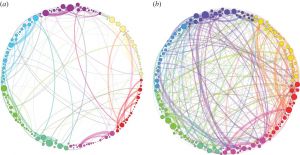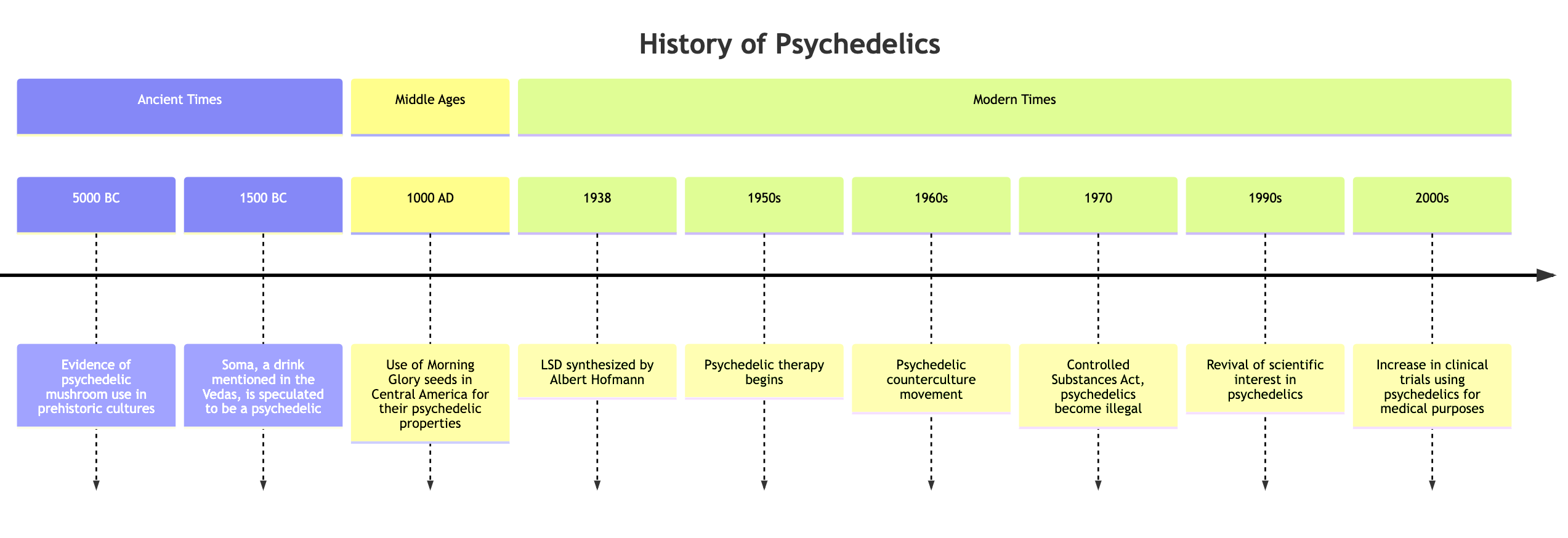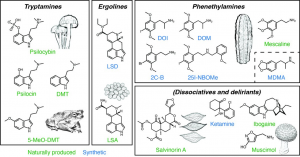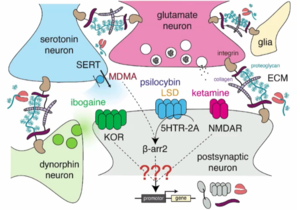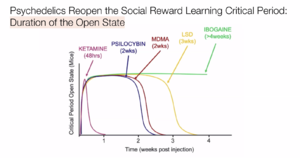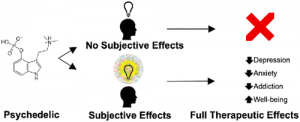Psychedelics
Psychedelics are medicines that induce Pivotal Mental States. Given the correct priming (set), setting and subsequent integration they can have potent psychoplastogen effects on the mind. During the psychedelic experience, as shown in the illustrated brain scan to the right (Figure 1) parts of the brain which do not usually communicate with one another start talking, opening subconscious inputs to the conscious mind. The experience is thought to open a neuroplastic window augmenting learning and cognitive and psychological flexibility[1]. Clinically this can be seen as introducing entropy into ruminating thought patterns thought to be the basis of mental illnesses such as bipolarity[2], depression and anxiety.
History
There has been a long and diverse history of human psychedelic use, stretching back at least 3,000 years. Historically, they were incorporated into various cultural practices: as Soma in India, Peyote among the Navajo, and Kykeon in the ancient Greek city of Eleusis. However, since the early 1970s, these substances have been mired in taboo. Today, we're witnessing a renewed interest in these compounds, often referred to as "The Psychedelic Renaissance." Current research indicates that they may be among the safest and most potent treatments for a range of mental health issues.
Psychedelic Compounds
There are 5 classes of psychedelics, which are classified on their effect and chemistry.
Tryptamines
- Psilocybin / psilocin found in magic mushrooms.
- DMT found in acacias and ayahuasca.
- 5-MeO-DMT found in toad venom.
Ergoline
- LSD derived from the rye fungus, ergot.
Phenylethylamines
- Mescaline found in the peyote cactus a Native American entheogen.
- MDMA and 2C-B synthetic compounds made by the chemist Alexander Shulgin.
Deliriants
- Muscimol found in 🍄 - amanita muscaria.
- Ibogaine, an African entheogen.
Dissociatives
- Ketamine a synthetic anaesthesia, which globally, is the most prescribed drug in this class.
- Nitrous oxide can induce mind-altering experiences, including feelings of bliss, spirituality, and the feeling of being outside of one's body[3].
Short Term Effects
Psychedelics induce a psychedelic experiences which encompass a wide range of sensory distortions, most common include:
Visual
- Increased apophenia
- Diffraction
- Object activation
- Visual acuity enhancement
- Visual agnosia
- Visual exposure to inner mechanics of consciousness
Cognitive
Novel
- Time distortion
- Conceptual thinking
- Thought loops
- Ego Death - Depersonalization
Enhancements
- Creativity enhancement
- Increased suggestibility
- Novelty enhancement
Suppressions
- Addiction suppression
- Personal bias suppression
Long Term Effects
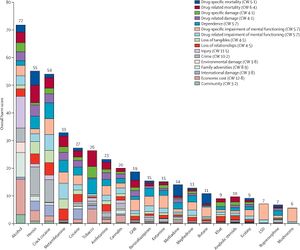
Compared to the majority of other medications, the dangers linked with psychedelic use are considerably lower (See Figure 3). Research indicates that certain personality traits such as neuroticism will negatively influence long term outcomes[5], whereas traits like a willingness to surrender can have a positive impact[6]. Clinically, provided that appropriate priming, setting and integration are in place, there is substantial evidence supporting the safe and effective use of psychedelics in treating various conditions:
- Depression - multiple meta-analyses results suggest that psychedelic-assisted therapy reduces MADRS with minimal adverse effects[7][8], relative to a comparable meta analysis of the effects of 21 traditional antidepressant drugs[9].
- Obsessive compulsive disorder (OCD)
- Post Traumatic Stress Disorder (PTSD)
- Alcoholism - the founder of AA cured his alcoholism using LSD[10].
- Tobacco Use - small study has shown an 80% cessation rate after 6 months which compare to the industry standard of 35%[11].
- Alzheimer's Protection - a small study has found that DMT can prevent Alzheimer's in rat studies[12].
- Hyper-Consumerism - several peer-reviewed studies have shown that psychedelics also work as ecodelics, medicines which can induce ecological concern[13][14][15][16][17][18][19][20][21].
Emotions and brain function are altered up to one month after a single high dose of psilocybin[22]. Psychedelic use correlates to lifetimes without depression[23]. Numerous studies[24] and a systematic review[25] have concluded that guided psychedelic therapy can further improve the above therapeutic effects.
Learning Enhancement
New evidence[26] suggests that psychedelics can enhance a specific type of learning called the reward learning rate which is how quickly an someone updates their knowledge or policy based on the rewards they receive from the environment.
Mechanism of Action
Psychedelics induce neuroplastic, pivotal mental states. It is thought psychedelics mediate this effect by activating 5HT2A and tyrosine kinase receptors causing the release of Brain-Derived Neurotrophic Factor (BDNF)[27] receptor TrkB[28].
Psychedelic Comparison
The most commonly used psychedelics, Psilocybin, DMT and LSD have a very similar effect[29][30][31][32] whilst dissociative psychedelics like ketamine have a more of an Out of Body Experience effect. This is backed up by recent, real world evidence analysis of 2947 publicly available, erowid.org trip reports which concluded:
"MDMA experience reports featured an emotionally intensifying profile accompanied by many cognitive process words and dynamic-personal language. In contrast, Ayahuasca and DMT experience reports involved relatively little emotional language, few cognitive process words, increased analytical thinking-associated language, and the most semantic similarity with psychedelic and mystical experience descriptions[33]. LSD, psilocybin mushroom, and ketamine reports showed only small differences on the emotion-, analytical thinking-, psychedelic, and mystical experience-related language outcomes. Further research has concluded: “Both doses of LSD and the high dose of psilocybin produced qualitatively and quantitatively very similar subjective effects, indicating that alterations of mind that are induced by LSD and psilocybin do not differ beyond the effect duration”[30].
| Class | Drug | Light High Dose | Normal Dose | Maximum Safe dose | Time to Onset* | Duration of Experience | Duration of Open State |
|---|---|---|---|---|---|---|---|
| Classic | LSD | 10-30 μg | 100 μg[34] | 1000-3000 μg | 0.25-2 hours | 6-11 hours | 3 weeks |
| DMT (inhaled) | 10-20 mg | 20-30 mg | 100 mg | Immediate | 15-30 minutes | - | |
| Psilocybin | 5-10 mg | 20mg | 150 mg | 0.5 hours | 3-6 hours | 2 weeks[35] | |
| Ibogaine | 0.87mg/kg[36] | 1-3 hours | Up to 48 hours[37] | >4 weeks | |||
| Mescaline | 50-200 mg | 400 mg | 1000 mg | <30 mins | 8-15 hours | - | |
| Empathogen | MDMA | 45-75mg | 75-125mg, 50% dose 150 mins later. | 20-30 min | 2-4 hours | 2 weeks | |
| 2-CB | - | ||||||
| Dissociative | Ketamine (Intranasal) | <30 minutes | 2 days | ||||
| Dextromethorphan | - |
Dosage information frequently changes and is dependent on weight and prior medical condition. Before administering check all information with a suitably qualified professional.
A key effect of psychedelics is their ability to open a period of neuroplasticity where old habits can be erased and new habits formed. This period has been found to differ substantially between the various compounds (see Figure 5).
Medicinal Chemistry
All psychedelics are chemically unique and can be categorised into four main types (see Figure 2). There are three main families of chemical compounds: tryptamines, phenethylamines, or lysergamides and many tend to act via serotonin 2A receptor agonism which plays a key role in the regulation of cortical function. Serotonin antagonism has been proposed as the mechanism for the subjective and biological effects of classical psychedelics as these effects are blocked after administering 5HT2AR antagonists such as ketanserin[38][39].
Who would be eligible for psychedelics from a doctor?
Psychedelic therapy is not for everyone. There are various inclusion and exclusion criteria for psychedelic therapy, these can vary dependent on which organisation you get access from. Below is a general list compiled from clinical trial data.
Exclusions Criteria
There are a category of patients that have specific conditions or are taking specific medicines that should be excluded from psychedelic therapy. In general these patients have the following characteristics:
- People taking quetiapine, risperidone, and olanzapine (an atypical antipsychotics) as there is some evidence to suggest it can terminate a trip[40];
- People taking 5HT2AR high affinity antidepressants such as amitriptyline, mirtazapine, and trazodone.[41]
- Presence of high degrees of Psychedelic Anxiety Syndrome;
- Presence or history of psychosis;
- Presence or history of mania or bipolar disorder;
- Presence or history of personality disorder;
Inclusion Criteria
To be able to obtain a psychedelic from a doctor all of the following criteria must be met:
- Over 25, this age is not written in stone and there will be some variability, however, it is thought that psychedelics should not be taken until brain growth is completed which occurs around the mid 20's.
- Diagnosed as having Treatment Resistant Depression, i.e. no adequate response to a course of appropriate antidepressant medication within a certain time.
Adverse effects
Like all medicines, without proper guidance, adverse effects can occur, many of which can be reduced by utilising proper inclusion and exclusion criteria. As shown in Figure 3, relative to other popular medicines psychedelics cause much less harm. However, there have been some adverse psychedelic effects which have been linked to the intensity and duration of the experience[42]. Scientific data suggests that there are two key factors in ensuring a good psychedelic trip include:
1. Being psychologically “well” in the days prior to the experience.
2. Being ready to surrender oneself to the experience.
Microdosing
The medical definition of microdosing is a dose given which is sub therapeutic, i.e. it is the dose doctors recognise as having no discernible effect. However, many claim, mainly via online survey studies, that very low doses of LSD, taken at 3–4-day intervals, improve mood and cognitive function[43].
In controlled studies, which in mental health are the gold standard, (see critical appraisal) the placebo effect is excluded. In all of these studies microdosing has been shown to have no effect[44] and even in some have shown negative effects such as neuroticism[45] or even the potential to cause valvular heart disease[46]. It has been suggested that this is because the experience of the trip is more important than the underlying chemical-electrical mechanisms[47] (see Figure 6) . By propagating the myth that microdosing does have an effect may cause people from not accessing the correct dose and getting the actual benefit from the medicine.
Oneirogens
An oneirogen, is a substance or experience which enhances dream states, in effect, this could be likened to an unconscious psychedelic state.
References
- ↑ A role for the serotonin 2A receptor in the expansion and functioning of human transmodal cortex. Andrea I Luppi, Manesh Girn, Fernando E Rosas, Christopher Timmermann, Leor Roseman, David Erritzoe, David J Nutt, Emmanuel A Stamatakis, R Nathan Spreng, Lei Xing. https://doi.org/10.1093/brain/awad311. Published: 13 September 2023
- ↑ Risks and benefits of psilocybin use in people with bipolar disorder: An international web-based survey on experiences of ‘magic mushroom’ consumption. Emma Morton, Kimberly Sakai, and Josh Woolley. Volume 37, Issue . https://doi.org/10.1177/02698811221131997. Accessed 23 Jan 2023 via https://journals.sagepub.com/doi/full/10.1177/02698811221131997
- ↑ Classical and non-classical psychedelic drugs induce common network changes in human cortex. Rui Dai, Tony E. Larkin, Zirui Huang, Vijay Tarnal, Paul Picton, Phillip E. Vlisides, Ellen Janke, Amy McKinney, Anthony G. Hudetz, Richard E. Harris, George A. Mashour. NeuroImage, 2023; 273: 120097 Accessed on 9 May 2023 via DOI: https://www.sciencedirect.com/science/article/pii/S1053811923002434
- ↑ Drug harms in the UK: a multicriteria decision analysis Prof David J Nutt, FMedSci, Leslie A King, PhD, Lawrence D Phillips, PhD on behalf of the Independent Scientific Committee on Drugs Published:November 01, 2010. DOI:https://doi.org/10.1016/S0140-6736(10)61462-6
- ↑ Quality of Acute Psychedelic Experience Predicts Therapeutic Efficacy of Psilocybin for Treatment-Resistant Depression. Roseman L, Nutt DJ, Carhart-Harris RL. Front Pharmacol. 2018 Jan 17;8:974. doi: 10.3389/fphar.2017.00974. PMID: 29387009; PMCID: PMC5776504.
- ↑ Predicting Responses to Psychedelics: A Prospective Study. Front. Pharmacol., 02 November 2018 Sec. Neuropharmacology. Volume 9 - 2018 | https://doi.org/10.3389/fphar.2018.00897
- ↑ Classic serotonergic psychedelics for mood and depressive symptoms: a meta-analysis of mood disorder patients and healthy participants. Nicole L. Galvão-Coelho, Psychopharmacology (Berl). 2021; 238(2): 341–354. Published online 2021 Jan 11. doi: 10.1007/s00213-020-05719-1. Accessed on 16th September 2022 via https://www.ncbi.nlm.nih.gov/pmc/articles/PMC7826317/pdf/213_2020_Article_5719.pdf
- ↑ A Meta-Analysis of Placebo-Controlled Trials of Psychedelic-Assisted Therapy. Luoma, J. B., Chwyl, C., Bathje, G. J., Davis, A. K., & Lancelotta, R. (2020). Journal of Psychoactive Drugs, 1–11. doi:10.1080/02791072.2020.1769878. Accessed on 16th September 2022 via: https://pubmed.ncbi.nlm.nih.gov/32529966/
- ↑ Comparative efficacy and acceptability of 21 antidepressant drugs for the acute treatment of adults with major depressive disorder: a systematic review and network meta-analysis. Andrea Cipriani, MD. Published in the Lancet. February 21, 2018 DOI:https://doi.org/10.1016/S0140-6736(17)32802-7
- ↑ A Radical New Approach to Beating Addiction. Psychology Today. Retrieved February 24, 2019, also Francis Hartigan Bill Wilson p. 177-179.
- ↑ An online survey of tobacco smoking cessation associated with naturalistic psychedelic use. Journal of Psychopharmacology, 31(7), 841–850. Johnson, M. W., Garcia-Romeu, A., Johnson, P. S., & Griffiths, R. R. (2017). doi:10.1177/0269881116684335. Accessed on 14th February 2023 via: https://pubmed.ncbi.nlm.nih.gov/28095732/
- ↑ N, N-Dimethyltryptamine, a natural hallucinogen, ameliorates Alzheimer’s disease by restoring neuronal Sigma-1 receptor-mediated endoplasmic reticulum-mitochondria crosstalk. Dan Cheng, Zhuo-Gui Lei, Kin Chu, Oi Jin Honey Lam, Chun Yuan Chiang & Zhang-Jin Zhang Alzheimer's Research & Therapy volume 16, Article number: 95 (2024)https://alzres.biomedcentral.com/articles/10.1186/s13195-024-01462-3#abbreviations
- ↑ Catalysts for Transformation: A systematic literature review exploring the interlinkages and potential role of classic psychedelics to social-ecological sustainability. Marion Nilsson, Lund University Centre for Sustainability Studies. Accessed on 30 January 2023 via: https://lup.lub.lu.se/luur/download?fileOId=9031166&func=downloadFile&recordOId=9031164
- ↑ Accidental Environmentalism: Nature and Cultivated Affect in European Neoshamanic Ayahuasca Consumption. Arne Harms University of Leipzig. Accessed on 30 Jan 2023 via https://www.proquest.com/openview/e872aeede38122f158ef3d84fbc39c38/1?cbl=18750
- ↑ Acute, subacute and long-term subjective effects of psilocybin in healthy humans: a pooled analysis of experimental studies. Studerus E, Kometer M, Hasler F, Vollenweider FX. J Psychopharmacol. 2011 Nov;25(11):1434-52. doi: 10.1177/0269881110382466. Epub 2010 Sep 20. PMID: 20855349. Accessed on 12 December 2022 via: https://pubmed.ncbi.nlm.nih.gov/20855349/
- ↑ Connectedness to Nature and to Humanity: their association and personality correlates. Front. Psychol., 21 July 2015. Sec. Personality and Social Psychology. Kibeom Lee, Michael C. Ashton, Julie Choi and Kayla Zachariassen. https://doi.org/10.3389/fpsyg.2015.01003. Accessed on 3rd October 2022 via https://www.frontiersin.org/articles/10.3389/fpsyg.2015.01003/full
- ↑ Increased nature relatedness and decreased authoritarian political views after psilocybin for treatment-resistant depression. Journal of Psychopharmacology. Taylor Lyons, Robin L Carhart-Harris. https://doi.org/10.1177/0269881117748902. Accessed on 3rd October 2022 via https://journals.sagepub.com/doi/full/10.1177/0269881117748902
- ↑ Psychedelics, Personality and Political Perspectives. Matthew M Nour 1, Lisa Evans 2, Robin L Carhart-Harris DOI: 10.1080/02791072.2017.1312643. 2017 Jul-Aug;49(3):182-191. doi: 10.1080/02791072.2017.1312643. Epub 2017 Apr 26. Accessed on 3rd October 2022 via https://pubmed.ncbi.nlm.nih.gov/28443703/
- ↑ Manifesting Minds: A Review of Psychedelics in Science, Medicine, Sex, and Spirituality. Doblin, Rick; Brad Burge (2014) North Atlantic Books. ISBN 1583947272.
- ↑ Lifetime experience with (classic) psychedelics predicts pro-environmental behavior through an increase in nature relatedness. Matthias Forstmann and Christina Sagioglou Journal of Psychopharmacology 2017. DOI: 10.1177/0269881117714049. Accessed on 30th September 2022 via: https://pubmed.ncbi.nlm.nih.gov/28631526/
- ↑ From Egoism to Ecoism: Psychedelics Increase Nature Relatedness in a State-Mediated and Context-Dependent Manner. Hannes Kettner, Sam Gandy, Eline C. H. M. Haijen and Robin L. Carhart-Harris Centre for Psychedelic Research, Department of Brain Sciences, Faculty of Medicine, Imperial College London. International Journal of Environmental Research and Public Health. Published: December 2019 DOI: 10.3390/ijerph16245147. Accessed on 30th September 2022 via: https://pubmed.ncbi.nlm.nih.gov/31888300/
- ↑ Emotions and brain function are altered up to one month after a single high dose of psilocybin. Barrett, F.S., Doss, M.K., Sepeda, N.D. et al. Sci Rep 10, 2214 (2020). https://doi.org/10.1038/s41598-020-59282-y
- ↑ Lifetime use of MDMA/ecstasy and psilocybin is associated with reduced odds of major depressive episodes. Grant M Jones., Matthew K Nock. Published January 5, 2022 in Volume 36, Issue 1 of Journal of Psychopharmacology. https://doi.org/10.1177/026988112
- ↑ Psychedelic-Assisted Psychotherapy: A Paradigm Shift in Psychiatric Research and Development. Eduardo Ekman Schenberg. Front Pharmacol. 2018; 9: 733. Published online 2018 Jul 5. doi: 10.3389/fphar.2018.00733.
- ↑ A systematic review of psychedelic-assisted psychotherapy for mental health: An evaluation of the current wave of research and suggestions for the future. Wheeler, S. W., & Dyer, N. L. (2020). Psychology of Consciousness: Theory, Research, and Practice, 7(3), 279–315. https://doi.org/10.1037/cns0000237
- ↑ Effect of lysergic acid diethylamide (LSD) on reinforcement learning in humans. Psychological Medicine, 1-12. doi:10.1017/S0033291722002963, Kanen, J., Luo, Q., Rostami Kandroodi, M., Cardinal, R., Robbins, T., Nutt, D., . . . Den Ouden, H. (2022). Accessed on 24 August 2023 via https://www.cambridge.org/core/journals/psychological-medicine/article/effect-of-lysergic-acid-diethylamide-lsd-on-reinforcement-learning-in-humans/28E41FEE97D3A8614C77DC54DF501489
- ↑ Psychedelics and Neuroplasticity: A Systematic Review Unraveling the Biological Underpinnings of Psychedelics Cato M. H. de Vos, Natasha L. Mason and Kim P. C. Kuypers* Department of Neuropsychology and Psychopharmacology, Faculty of Psychology and Neuroscience, Maastricht University, Maastricht, Netherlands Front. Psychiatry, 10 September 2021
- ↑ Psychedelics promote plasticity by directly binding to BDNF receptor TrkB. Rafael Moliner, Mykhailo Girych. Published: 05 June 2023 in Nature Neuroscience. Accessed on 8 Jun 2023 via: https://www.nature.com/articles/s41593-023-01316-5
- ↑ Effects of Naturalistic Psychedelic Use on Depression, Anxiety, and Well-Being: Associations With Patterns of Use, Reported Harms, and Transformative Mental States. Front. Psychiatry, 15 March 2022. Sec. Psychopharmacology. https://doi.org/10.3389/fpsyt.2022.831092
- ↑ Jump up to: 30.0 30.1 Direct comparison of the acute effects of lysergic acid diethylamide and psilocybin in a double-blind placebo-controlled study in healthy subjects. Holze, F., Ley, L., Müller, F. et al. Neuropsychopharmacol. 47, 1180–1187 (2022). https://doi.org/10.1038/s41386-022-01297-2
- ↑ Double-blind comparison of the two hallucinogens psilocybin and dextromethorphan: similarities and differences in subjective experiences. Carbonaro TM, Johnson MW, Hurwitz E, Griffiths RR. Psychopharmacology (Berl). 2018 Feb;235(2):521-534. doi: 10.1007/s00213-017-4769-4. Epub 2017 Nov 7. PMID: 29116367; PMCID: PMC6645364.
- ↑ Comparison of the Reactions Induced by Psilocybin and LSD-25 in Man. From the National Institute of Mental Health, Addiction Research Center, U. S. Public Health Service, Lexington, Kentucky by HARRIS ISBELL 1959
- ↑ Analysis of recreational psychedelic substance use experiences classified by substance. Adrian Hase, Max Erdmann, Verena Limbach & Gregor Hasler Psychopharmacology volume 239, pages643–659 (2022) Altmetric Metrics https://link.springer.com/article/10.1007/s00213-022-06062-3
- ↑ Dose-response relationships of LSD-induced subjective experiences in humans. Journal of neuropsychopharmacology Tim Hirschfeld, Johanna Prugger, Tomislav Majić & Timo T. Schmidt. Published: 09 May 2023, accessed on 4 Jun 2023 via https://www.nature.com/articles/s41386-023-01588-2
- ↑ Sub-acute effects of psilocybin on EEG correlates of neural plasticity in major depression: Relationship to symptoms. Patrick D Skosnik, Volume 37, Issue 7 https://doi.org/10.1177/02698811231179800. https://journals.sagepub.com/doi/abs/10.1177/02698811231179800?journalCode=jopa&s=03
- ↑ Ibogaine for treating drug dependence. What is a safe dose? Drug Alcohol Depend. Schep LJ, Slaughter RJ, Galea S, Newcombe D. 2016 Sep 1;166:1-5. doi: 10.1016/j.drugalcdep.2016.07.005. Epub 2016 Jul 15. PMID: 27426011. Accessed on 17th Jul 2023 via https://pubmed.ncbi.nlm.nih.gov/27426011/
- ↑ Tabernanthe iboga is a shrub of West Africa, whose roots are used for stimulatory, hallucinogenic, and sedative properties (Ujváry, 2014). Addictive Substances and Neurological Disease, 2017. Accessed 17 Jul 2023 via: https://www.sciencedirect.com/topics/neuroscience/tabernanthe-iboga
- ↑ The Fabric of Meaning and Subjective Effects in LSD-Induced States Depend on Serotonin 2A Receptor Activation. Preller KH, Herdener M, Pokorny T, Planzer A, Kraehenmann R, Stämpfli P, et al. Curr Biol. 2017 Feb;27(3):451–7. Accessed 14th February 2023 via: https://pubmed.ncbi.nlm.nih.gov/28132813/
- ↑ Psychedelics Promote Structural and Functional Neural Plasticity. Ly C, Greb AC, Cameron LP, Wong JM, Barragan EV, Wilson PC, et al. Cell Rep. 2018 Jun 12;23(11):3170–82. Accessed on 14th February 2023 via: https://www.ncbi.nlm.nih.gov/pmc/articles/PMC6082376/
- ↑ Olanzapine as the ideal “trip terminator”? Giuseppe Valeriani, Ornella Corazza, Francesco Saverio Bersani. First published: 28 July 2015 https://doi.org/10.1002/hup.2431. Accessed via: https://onlinelibrary.wiley.com/doi/10.1002/hup.2431
- ↑ The fabric of meaning and subjective effects in LSD-induced states depend on serotonin 2A receptor activation. K.H. Preller, M. Herdener, T. Pokorny, A. Planzer, R. Kraehenmann, P. Stämpfli, et al. https://www.sciencedirect.com/science/article/pii/S096098221631510X
- ↑ Extended difficulties following the use of psychedelic drugs: A mixed methods study Evans, J., Queen Mary University. Accessed on 31 July 2023 via: https://papers.ssrn.com/sol3/papers.cfm?abstract_id=4505228
- ↑ Exploring the effect of microdosing psychedelics on creativity in an open-label natural setting. Prochazkova, L., Lippelt, D.P., Colzato, L.S. et al. Psychopharmacology 235, 3401–3413 (2018). https://doi.org/10.1007/s00213-018-5049-7
- ↑ Repeated low doses of LSD in healthy adults: A placebo-controlled, dose–response study Harriet de Wit,Hanna M. Molla,Anya Bershad,Michael Bremmer,Royce Lee First published: 01 February 2022 https://doi.org/10.1111/adb.13143https://onlinelibrary.wiley.com/doi/abs/10.1111/adb.13143
- ↑ A Systematic Study of Microdosing. Richard J. Stevenson, Macquarie University, Sydney, Australia. 10.1371/journal.pone.0211023
- ↑ The risk of chronic psychedelic and MDMA microdosing for valvular heart disease. Michael Tagen, Daniel Mantuani, Journal of Psychopharmacology, Volume 37, Issue 9. Accessed on 4 October 2023 via: https://journals.sagepub.com/doi/10.1177/02698811231190865
- ↑ The Subjective Effects of Psychedelics Are Necessary for Their Enduring Therapeutic Effects: David B. Yaden and Roland R. Griffiths* ACS Pharmacol. Transl. Sci. 2021, 4, 2, 568–572. Publication Date:December 10, 2020. https://doi.org/10.1021/acsptsci.0c00194
